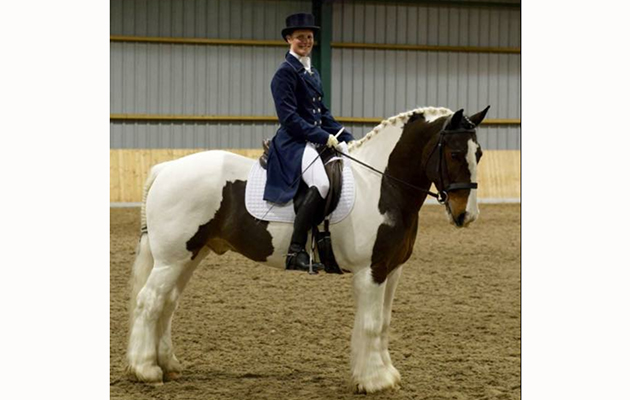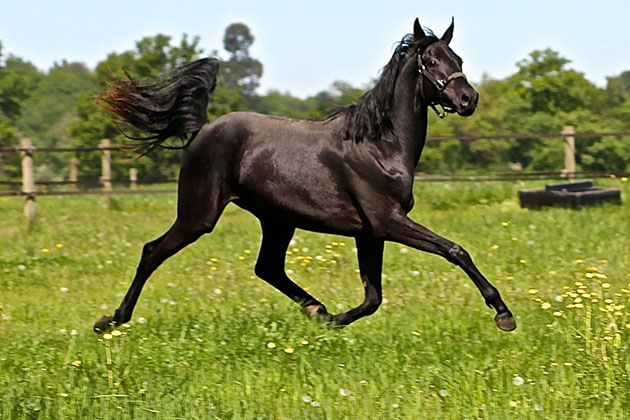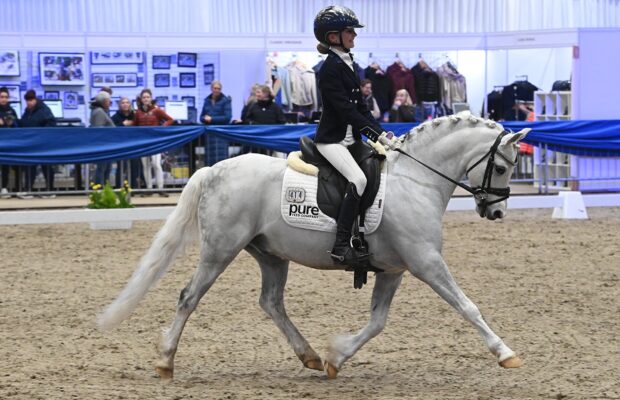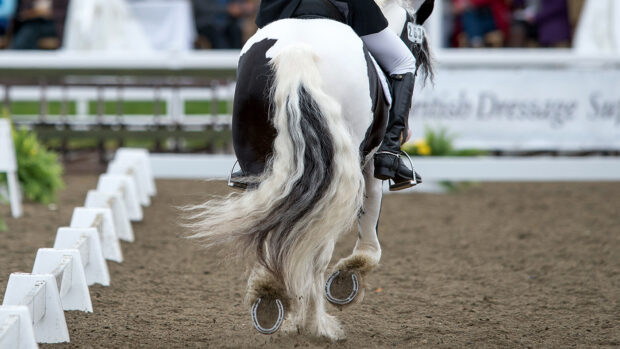What are the best horse breeds for dressage? Well, dressage in its simplest form means “training”, and is all about working in harmony with your horse to help him improve suppleness, flexibility, obedience and athleticism – and ultimately become more pleasant and responsive to ride. As a result, any breed of horse has the ability to do dressage, and as long as they have reasonable conformation, should be able to attain a basic standard. However, some horse breeds are certainly more suited to the high levels of the sport. We take a look at some of those here…
Warmbloods
The vast majority of horses you will see competing successfully in top level dressage are warmbloods. A warmblood is an athletic, modern type of horse originally produced by crossing a hot-blooded horses, such as a thoroughbred, with the cold-blooded horse, such as a draught horse.
You will hear horses referred to as a German warmblood, for example, or a Danish warmblood, or a Dutch warmblood. This means a horse of one of the studbook organisations from that country, for example a Dutch warmblood is a horse bred under the KWPN studbook. A German warmblood could be one of many German horse breeds, including the Oldenburg, Westfalian, Hanoverian and Trakehner.
When it comes to the most successful horse breeds in dressage, it is interesting to look at the 18 horses that reached the individual dressage final at the Tokyo Olympics in 2021. Nine of them, so 50%, were KWPN. Three were Hanoverian, two were Westfalian, and one each represented the Trakehner, Danish Warmblood and Oldenburg breeds. Only one horse out of the 18 was not a warmblood, and that was Fogoso, a Lusitano stallion who finished 16th for Portugal’s Rodrigo.
While the KWPN breed clearly dominates the list, the top three horses who reached the podium were of three different breeds: Jessica von Bredow-Werndl’s ride TSF Dalera (Trakehner), Isabell Werth’s ride Bella Rose (Westfalian) and Charlotte Dujardin’s Gio (KWPN).
A warmblood horse’s individual bloodlines, talent, temperament and training will have greater influence when it comes to success in sport than its specific breed. That said, it is notable that arguably the two greatest dressage horses of all time, Totilas and Valegro, were both KWPN, which speaks volumes for the influence of the breed on modern dressage.
Iberian breeds
Horse breeds from the Iberian peninsula have become increasingly popular for dressage in recent years. These breeds include the Spanish PRE (Pura Raza Española) and Andalusian horses, and the Portuguese Lusitano horse.
At the Tokyo Olympics, every member of the Portugal team rode Lusitano horses, which illustrates the breed’s ability to perform top level dressage. The team finished eighth.

Portugal’s Rodrigo Torres and the Lusitano stallion Fogoso at the Tokyo Olympics in 2021
Iberian horse breeds typically possess excellent temperaments and trainability, and often show particular aptitude for the collected work, which gives them an advantage when it comes to exercises such as piaffe and passage at the very top level.
One of the most famous Iberian dressage horses is the PRE stallion Fuego de Cardenas, who finished in the top 10 individually at the 2010 World Equestrian Games, the 2011 European championships and the 2012 Olympics, gaining a plethora of fans along the way.
And it’s not just riders from Spain or Portugal who opt to ride Iberian horses: Brazil’s Joao Victor Marcari Oliva rode Lusitano stallion Escorial in Tokyo, and British riders such as Vicki Thomson-Winfield, Jacky Stolper, Becky Edwards and Karen Shepherd have had great success competing Iberian breeds at high level.
Draught horses
The sight of heavy horses, or part-bred heavy horses, is becoming a more familiar one on the UK dressage scene. This group of horse breeds include the Clydesdale horse, Shire horse, Suffolk, Irish draught, Cleveland Bay and Haflinger.

Kate Dwyer riding Snowden Faberge for Ireland at the 2019 European Championships
Examples of part-bred Cleveland Bay horses reaching the highest levels include Arun Tor, ridden by Ferdi Eilberg, and more recently Spring Pascal, ridden by Samantha Thurman-Baker. The part-bred Shire horse Snowden Faberge, ridden by Kate Dwyer, was part of the Irish team at the European championships in 2019 who secured Ireland’s qualification for the Tokyo Olympics, and has also banked international wins at grand prix level.
British native breeds
While seen far less frequently at the top level of the sport, plenty of Britain’s native breeds can turn their hands successfully to dressage at national level. Every year, the National Dressage Championships and Winter Dressage Championships welcome a huge range of breeds to compete, from Welsh section Ds and Connemaras to Fell ponies.
As you go up the levels, it is part-breds that tend to prevail, although it is rare to see a part-bred native breed reaching the very top level of dressage. It’s not unheard of though, for example the Connemara/thoroughbred Seldom Seen competed at grand prix in the late 1980s with Lendon Gray.
Cobs

Once considered only destined for weight-carrying and happy hacking, a cob with good conformation and a great attitude is more than capable of doing well in dressage, with some even reaching grand prix levels. This includes traditional gypsy cobs, such as Sam Turner’s Cuffstown Rumble (above), who has competed at grand prix.
Thoroughbreds
The thoroughbred is a hugely influential horse breed in dressage, contributing to the modern warmblood to create what we tend to now think of a sport horse, but nowadays it is rare to see pure thoroughbreds competing at high level in dressage.
However, with several series and championships specifically targeting thoroughbreds and retrained racehorses, more and more are becoming popular and successful at lower levels of the sport, with a few even working their way further up, such as ex-racehorse Quadrille, owned and bred by The Queen and ridden by Louise Robson, who competes at small tour.
You may also be interested in…

What is a KWPN? H&H explains…
Discover everything you need to know about this Dutch breed of horse

Meet the striking grand prix stallion whose breed you’ve probably never heard of
One of the lesser known Baroque breeds, this 11-year-old stallion is thought to be the only Murgese horse to reach

H&H’s Tokyo horse of the day: the Lusitano stallion who stepped up to fill his ‘brother’s’ shoes

Subscribe to Horse & Hound magazine today – and enjoy unlimited website access all year round
Horse & Hound magazine, out every Thursday, is packed with all the latest news and reports, as well as interviews, specials, nostalgia, vet and training advice. Find how you can enjoy the magazine delivered to your door every week, plus options to upgrade your subscription to access our online service that brings you breaking news and reports as well as other benefits.




